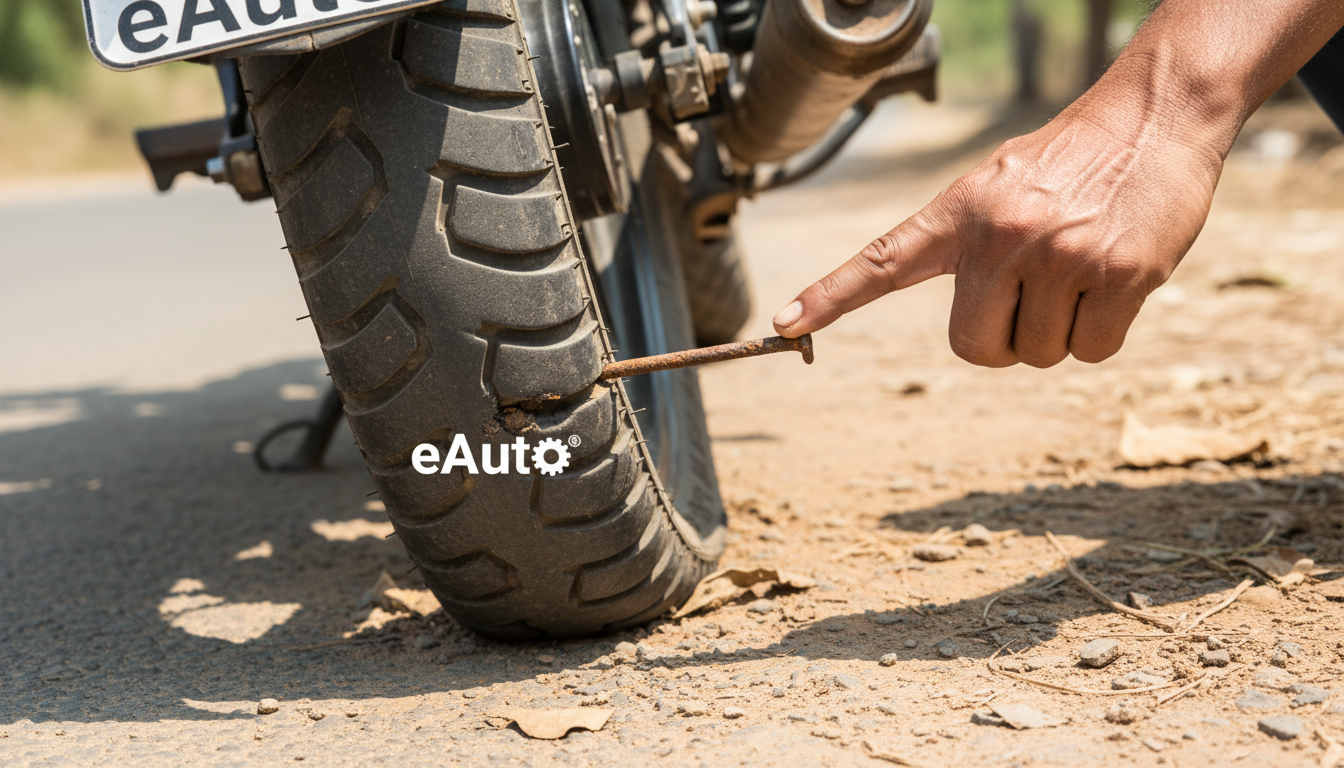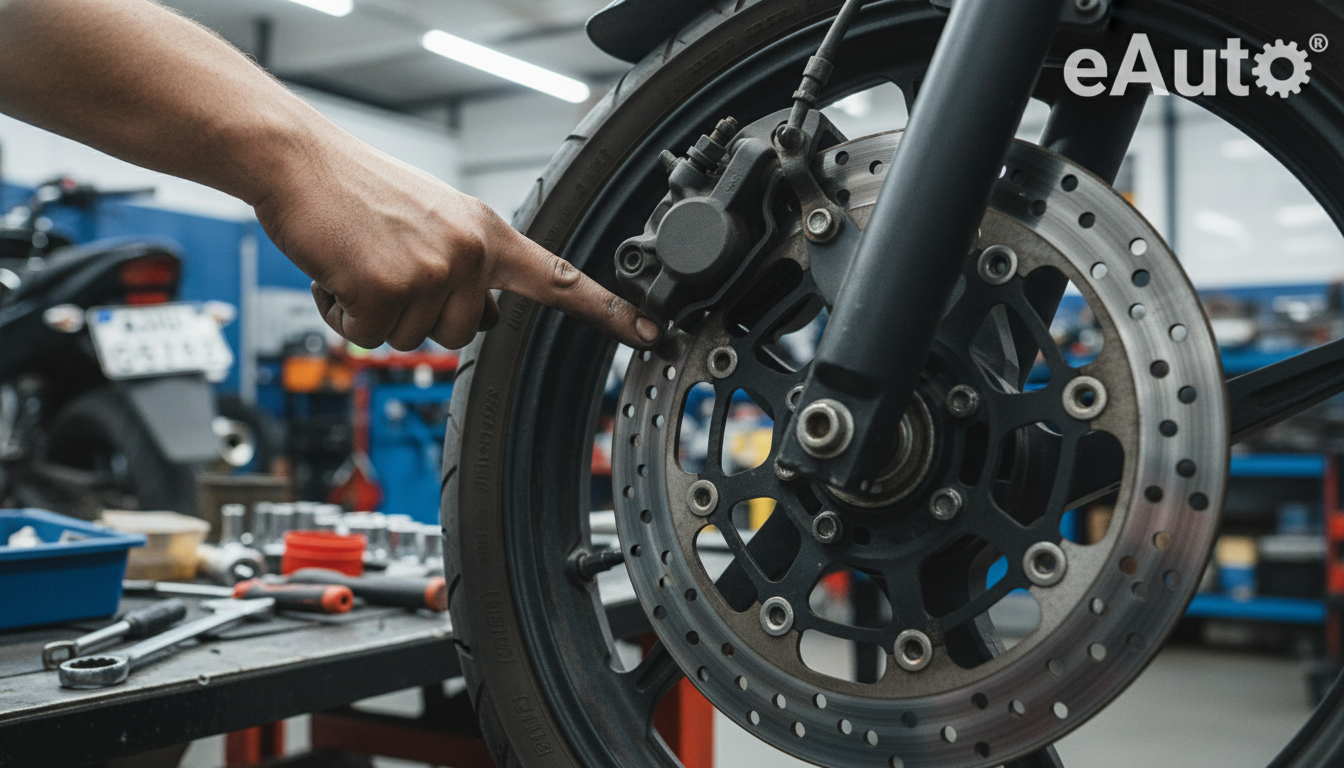Ever found yourself stranded on a busy Indian road, scratching your head over a sputtering engine or a flat tyre? We've all been there! Our beloved motorcycles are our lifeline, navigating through city traffic, highway adventures, and even the occasional tough rural patch. But let's be honest, the Indian riding environment—with its infamous potholes, dust, unpredictable traffic, and varying weather—can be quite demanding on our two-wheeled companions.
At eAuto, we understand the frustration of a breakdown, especially when you're far from a mechanic. That's why we’ve put together this comprehensive guide on the most common motorcycle problems in India and, more importantly, how you can fix them yourself or at least identify the issue before heading to a workshop. Getting a heads-up on minor repairs can save you time, money, and a whole lot of stress!
- ▸ The Usual Suspects: Common Motorcycle Woes
- • 1. Puncture Perils: The Indian Road Classic
- • 2. Chain Chatter and Slacks
- • 3. Battery Blues: Starting Trouble
- • 4. Braking Woes: Spongy or Hard Brakes
- • 5. Electrical Gremlins: Lights, Horns, and More
- • 6. Carburetor or Fuel Injection Issues
- • 7. Clutch Complications
- ▸ Preventive Maintenance: Your Best Defense
- ▸ When to Call the Pros
- ▸ FAQ: Frequently Asked Questions
- ▸ Conclusion: Keep Riding Smoothly!
The Usual Suspects: Common Motorcycle Woes
Let's dive into the nitty-gritty. Based on our experience on Indian roads, these are the issues that crop up most frequently.
1. Puncture Perils: The Indian Road Classic
Ah, the dreaded puncture! With construction debris, sharp stones, and glass shards aplenty, it's almost a rite of passage for Indian riders. Tubeless tyres have made it less of a nightmare, but it still happens.

- Symptom: Sudden loss of air pressure, wobbling at speed, bike pulling to one side.
- DIY Fix: For tubeless tyres, a temporary puncture repair kit (worm-type) can get you to the nearest workshop. Insert the repair strip after reaming the hole. For tube tyres, you'll need to remove the wheel and get the tube patched.
Prevention: Always carry a portable air pump and a tubeless repair kit, especially on long rides. Check tyre pressure regularly and visually inspect for embedded objects before a ride. Maintaining correct tyre pressure (as per your bike's manual) helps prevent punctures and increases tyre life.
2. Chain Chatter and Slacks
The drive chain is crucial for transmitting power to the rear wheel. Neglecting it leads to noise, poor performance, and even chain breakage. Indian dust and mud are prime culprits here.
- Symptom: A loud 'clack-clack' noise from the rear, especially when accelerating or decelerating; jerky power delivery; visible slack in the chain.
- DIY Fix: Clean and lubricate your chain every 500-700 km or after a rainy ride. Use a chain cleaner, brush off grime, and apply chain lube. Check chain slack (usually 20-30mm) as per your bike's manual. Adjusters typically located at the rear axle allow you to tighten it. Be careful not to over-tighten!
Prevention: Regular cleaning and lubrication are key. Avoid riding through deep puddles if possible, as water washes away lube quickly.
3. Battery Blues: Starting Trouble
A dead battery is a nightmare, especially when you're rushing to work. It's often the cause of a bike not starting or electricals failing.
- Symptom: Engine crank but doesn't start; dim headlights; weak horn; self-start clicking but no action.
- DIY Fix: First, check battery terminals for corrosion (white powdery substance). Clean them with a wire brush and apply petroleum jelly. If it's a lead-acid battery, check the electrolyte level; top up with distilled water if low. For modern MF (Maintenance Free) or Lithium-ion batteries, ensure connections are tight. If the battery is completely flat, try push-starting your bike (if it's not a fuel-injected model that requires minimum voltage).
Prevention: Don't leave your ignition on when the engine is off. Take your bike for short rides regularly to keep the battery charged. If storing for long periods, consider a trickle charger. Batteries typically last 2-3 years in India's climate; replace when performance drops significantly.
4. Braking Woes: Spongy or Hard Brakes
Effective brakes are non-negotiable for safety, especially in Indian traffic. Any issue here needs immediate attention.

- Symptom: Lever feels too soft/spongy (discs) or requires too much force (drums); grinding noise; reduced braking efficiency.
- DIY Fix: For disc brakes, check brake fluid level in the reservoir. If low, top it up with the recommended DOT fluid. Never mix different types. For both disc and drum brakes, inspect brake pads/shoes for wear. If they are worn thin (less than 1-2mm), they need replacement. For drum brakes, check for proper adjustment via the nut on the brake cable/rod.
Prevention: Replace brake fluid every 2 years. Get brake pads/shoes checked during every service. Avoid riding with your hand resting on the brake lever, as it causes premature wear.
5. Electrical Gremlins: Lights, Horns, and More
From non-functional indicators to a dead horn, electrical issues can be annoying and dangerous, especially at night or in heavy traffic.
- Symptom: Headlights, tail lights, or indicators not working; horn silent; instrument cluster not lighting up.
- DIY Fix: Start by checking the fuses. Your bike's fuse box is usually under the seat or near the battery. Replace blown fuses with one of the same amperage. Also, check for loose connections or corroded wires, especially near the faulty component. A quick tap on a stuck horn might sometimes temporarily fix it.
Prevention: Avoid aftermarket electrical modifications unless done by an expert. Protect wiring harnesses during heavy rains or washing. Regularly check all lights and the horn's functionality.
6. Carburetor or Fuel Injection Issues
The fuel system ensures your engine gets the right fuel-air mixture. Issues here lead to rough idling, poor mileage, and stalling.
- Symptom: Rough idling; engine stalling; poor throttle response; black smoke from exhaust; reduced fuel efficiency.
- DIY Fix (for Carburetor): Check if the choke is fully disengaged. Inspect the air filter; a clogged filter can cause rich mixture. Replace if dirty. You can try adding a fuel system cleaner to your petrol tank. For more complex issues like jet cleaning or float adjustment, it's best left to a mechanic.
- DIY Fix (for Fuel Injection): Fuel-injected bikes are more complex. Check the fuel tank for correct fuel level. Ensure the fuel pump whirs when you turn on ignition. Beyond that, FI issues often require diagnostic tools, so a trip to the service centre is likely.
Prevention: Always use good quality fuel. Get your air filter cleaned/replaced as per service schedule. Avoid running the tank on extremely low fuel, especially for FI bikes, as it can damage the fuel pump.
7. Clutch Complications
A smooth clutch operation is essential for seamless gear changes and preventing engine strain, especially in stop-and-go Indian traffic.
- Symptom: Clutch lever feels too hard or too loose; difficulty shifting gears; engine revving high but bike not accelerating (slipping clutch); bike lurching forward when engaging gear (dragging clutch).
- DIY Fix: Check the clutch cable for proper slack (usually 10-20mm at the lever's end). Many bikes have an adjuster near the clutch lever or at the engine side to fine-tune the free play. If the cable is frayed or rusted, it needs replacement. For a slipping clutch, if adjustment doesn't help, it indicates worn clutch plates, which require professional replacement.
Prevention: Avoid riding with your hand resting on the clutch lever. Use the clutch smoothly and avoid sudden, aggressive releases. Regular cable lubrication can also prolong its life.
Preventive Maintenance: Your Best Defense
An ounce of prevention is worth a pound of cure, especially with your motorcycle. Here are some general tips for Indian conditions:
- Regular Servicing: Stick to your manufacturer's service schedule. It’s not just a recommendation, it’s crucial for longevity.
- Daily Checks: Before every ride, do a quick walk-around. Check tyres, lights, horn, and fluid levels.
- Cleanliness: Wash your bike regularly, especially after riding in rain or dusty conditions. Dirt and grime can hide issues and accelerate wear.
- Quality Spares: When replacing parts, always opt for genuine or OEM-quality spares. Cheap parts might save you a few rupees but can cost you dearly in the long run.
- Owner's Manual: This is your bible! It contains specific maintenance schedules, fluid types, and adjustment procedures for your model.
- Riding Style: Smooth acceleration, braking, and gear changes reduce wear and tear on all components.
When to Call the Pros
While DIY fixes are empowering, know your limits. Don't hesitate to visit a trusted mechanic or authorised service centre for:
- Engine internals (valve clearance, piston rings, crankshaft issues).
- Complex electrical diagnostics (especially for modern bikes with ECUs and sensors).
- Suspension overhauls.
- Frame or structural damage.
- Brake fluid bleeding (if you're not confident).
- Any issue that makes you feel unsafe riding the bike.

FAQ: Frequently Asked Questions
Frequently Asked Questions
Conclusion: Keep Riding Smoothly!
Riding a motorcycle in India is an experience like no other – a blend of freedom, excitement, and sometimes, a little bit of improvisation. Knowing these common problems and how to tackle them can empower you to handle minor hiccups confidently and keep your machine running smoothly.
Remember, regular care and attention go a long way in ensuring your motorcycle remains a reliable companion on countless journeys. So, go ahead, get your hands a little dirty, understand your bike better, and keep riding safe!



